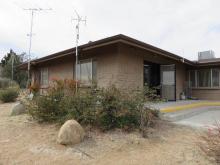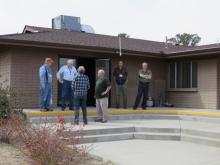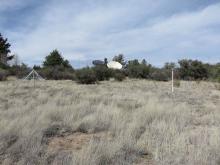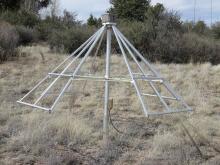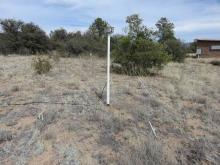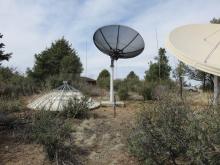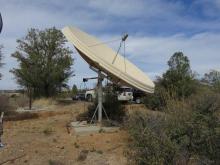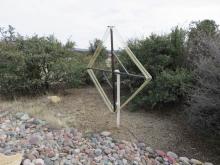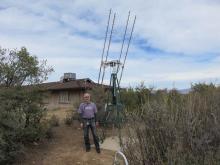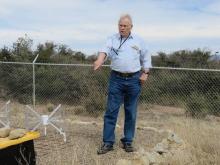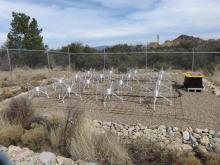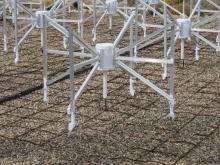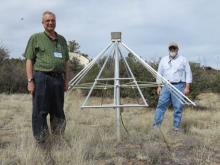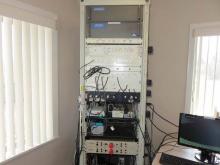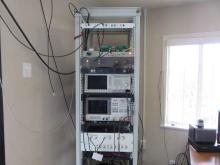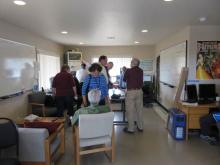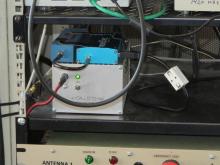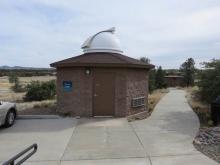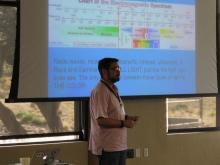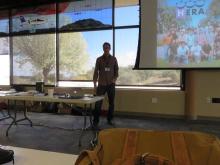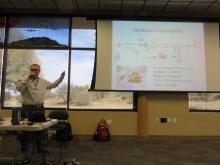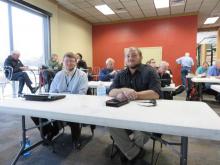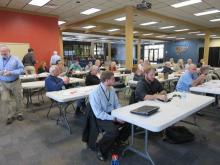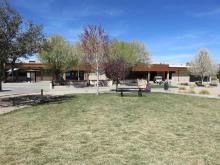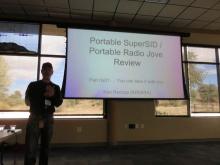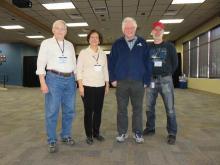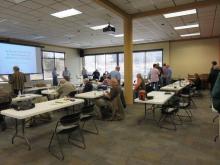The 2016 SARA Western Conference was held on the Embry-Riddle Aeronautical University campus a few miles outside of Prescott, Arizona USA over the weekend of 11~13 March. Ray Fobes was our host and he, Dave Westman, Keith Payea, and Lorraine Rumley worked hard to setup and manage the event. We had 33± attendees and speakers at this year’s conference, including many familiar members and several new members from the local Yavapai Amateur Radio Club. The conference agenda included a tour on Friday afternoon of the ERAU Radio Observatory, built under Ray Fobes’ supervision, and presentations by SARA members and outside speakers on Saturday and Sunday. The weather was very sunny and pleasant.
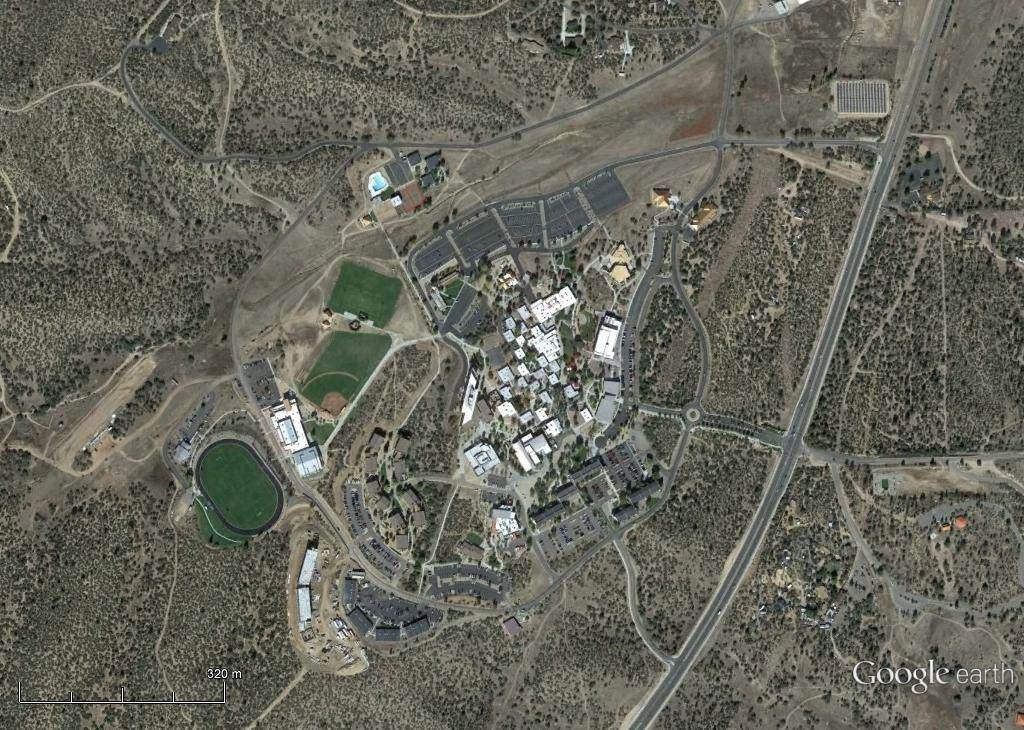
ERAU campus from 3 km altitude; the radio observatory is near the top edge right of center
Our guest speakers were Adam Beardsley and Chris Groppi, both from Arizona State University, and Brian Rachford from ERAU. Adam’s presentation, The Hydrogen Epoch of Reionization Array (HERA), The Next Step in Radio Cosmology, told us a brief history of the universe followed by a description of the array of dish reflector antennas to be deployed in South Africa. There will be 350 antennas, each 14 m diameter and covering the frequency range 100 to 200 MHz. The feeds will make use of the MWA (Murchison Widefield Array) and PAPER (Precision Array for Probing the Epoch of Reionization) antenna designs by hanging the smaller antenna upside-down over each dish reflector. He also discussed the challenges of foreground subtraction – the process of removing man-made and natural radio contamination from the data. The remaining data hopefully contains red-shifted emissions from what is thought to be the reionization of the universe’s ubiquitous hydrogen when the first stars and galaxies were formed. Chris’ presentation on Terahertz Frequency Radio Astronomy in Antarctica was a very interesting photo essay on his travels to Antarctica to launch balloon payloads with extremely short wavelength radio instruments. Brian is primarily an optical astronomer but his presentation, Using High-Bandwidth FM Broadcast Band SDR Recordings for Meteors, covered a type of radio observation very familiar to many SARA members – using relatively inexpensive software defined radio receivers to capture spectrums from the FM broadcast band for later analysis of meteor trail reflections. Brian’s data files often exceed a terabyte, and he obviously has plenty of storage capacity.

The 2-day conference was packed with many other presentations, including a presentation by two high school students, Xander Pickard and Collin Miller, from Colorado who presented their measurements of both red-shifted and blue-shifted neutral hydrogen emissions from two celestial sources, Cassiopeia A and Rosette Nebula, using the 20 m dish at the NRAO facility in Greenbank, West Virginia. Ray Fobes gave us a rundown on the relatively inexpensive miniVNA Pro and miniVNA Tiny vector network analyzers and also updated us on the many activities and new instruments at the radio observatory since our last conference at ERAU in 2011.
One of the presentations by Skip Crilly will be of interest to attendees of future SARA Eastern Conferences at Greenbank. Skip is responsible for upkeep on the 40 ft radio telescope at Greenbank and he recently made major changes to the link from the dual polarization low noise amplifiers at the feed to the detectors. He installed RF-over-fiber signal cables and associated interfaces and removed the unused right-hand relay rack in the underground observation hut. Observers can now use their own receivers if they wish or continue using the on-site detectors (the conference proceedings provides a detailed description of Skip’s changes).
Bogdan Vacaliuc setup a poster and equipment display and also made a presentation on the RASDR3, which evolved from the RASDR2. The RASDR3 layout has been revised to allow easier expansion and accommodation of Raspberry Pi Hats. This will allow users to customize their RASDR3 receivers using readily available or customized components and printed circuit boards. To take advantage of volume component pricing, the RASDR3 project requires about 100 pre-orders. Jay Wilson’s presentation, Practical Systems for Remote Control of Amateur Radio Telescope Installations, provided information on his experience at Little Thompson Observatory using TeamViewer, Ham Radio Deluxe, Remote Rig and other remote control interfaces. Remote control of radio telescopes is often necessary because they must be located in areas with low RFI, usually far off the beaten path. Our inimitable SARA President Ken Redcap compared SDR-Sharp and ra_simple software in total power radio telescopes and the challenges associated with installing ra_simple on a Linux PC (conclusion: ra_simple is not simple to install).
We had a total of 14 presentations, all at the Student Union building (“The Hangar”). The above reviews only a few of the presentations but all were relevant and informative. See the photo gallery and conference schedule immediately following this narrative and also refer to the conference proceedings (each attendee received the proceedings in printed copy and CD, and these are available from the SARA store).
One of the many activities associated with SARA Western conferences is the drawing for items related to amateur radio astronomy, such as the SuperSID and SARA document CDs. Each registered attendee wrote a card with their name on it, which was pulled from Ken Redcap’s red cap until everything was given away.
Another tradition of the SARA Western conferences is the social gatherings at local restaurants in the evenings. On Friday evening many attendees met at the Prescott Station Grill & Bar (not the Prescott Station Bar & Grill) in downtown Prescott for a variety of southwestern style food. On Saturday evening we all met at Augie’s Restaurant in the Frontier Village Center on Highway 69. Our daytime breakfast and lunch meals were provided as part of the conference through the ERAU on-campus Dining Hall.
If you did not attend the 2016 SARA Western Conference, you missed wonderful technical sessions and a chance to learn from and talk to your friends and colleagues and scientists. We are grateful to ERAU and especially Ray Fobes for his help and hospitality.
Western Conference Schedule ~ March 11-13, 2016, Embry-Riddle Aeronautical University, Prescott, AZ
|
Time |
Activity |
Presenter |
Location/title |
|
Friday, March 11 |
|
|
|
|
1:00 PM |
Registration |
Lorraine Rumley |
Observatory |
|
3:00 PM |
Tour of ERAU RA facility |
Ray Fobes |
Observatory |
|
6:00 PM |
Dinner at Prescott Station Grill & Bar |
|
|
|
|
|
|
|
|
Saturday, March 12 |
|
|
|
|
8:00 – 9:00 AM |
Registration, Breakfast |
L. Rumley |
Student Union Lower Hanger |
|
9:00 – 9:15 AM |
Introductions, etc. |
Ken Redcap |
|
|
9:15 – 10:00 AM |
Speaker 1 |
Adam Beardsley |
The Hydrogen Epoch of Reionization Array: The Next Step in Radio Cosmology |
|
10:00 – 10:45 AM |
Speaker 2 |
Chris Groppi |
THz Frequency Radio Astronomy in Antarctica |
|
10:45 – 11:15 AM |
Morning Break |
|
|
|
11:15 – 12:00 PM |
Speaker 3 |
Ray Fobes |
The miniVNA Tiny Vector Network Analyzer |
|
12:00 – 1:00 PM |
Lunch |
|
|
|
1:00 – 1:45 PM |
Speaker 4 |
Students from Berthoud High School, Colorado |
Investigating Simultaneous Red and Blue Shifts in HI Emissions from Nebula. |
|
1:45 – 2:30 PM |
Speaker 5 |
Ken Redcap |
Portable SuperSID / Portable Radio Jove Review |
|
2:30 – 3:00 PM |
Afternoon break |
|
|
|
3:00 – 3:45 PM |
Speaker 6 |
Skip Crilly |
Narrow Bandwidth Radio Bursts Observed using the Green Bank Forty Foot Telescope and a Home-built Five Meter Telescope |
|
3:45 – 4:30 PM |
Speaker 7 |
Tom Hagen |
21 cm Adventures—Building Antennas and Using SDR's to Detect HI and Continuum at 1.42040571..... GHz |
|
4:30 PM |
Adjourn |
|
|
|
6:00 PM |
Dinner at Augie’s Restaurant |
|
|
|
|
|
|
|
|
Sunday, March 13 |
|
|
|
|
8:30 – 9:00 AM |
Breakfast |
|
|
|
9:00 – 9:45 AM |
Speaker 8 |
Ken Redcap |
Off The Shelf Radio Telescope (continued) Using SimpleRA (instead of SDRSharp) |
|
9:45 – 10:30 AM |
Speaker 9 |
Whitham Reeve |
Geomagnetic Activity during Alaska’s 2015 Autumn |
|
10:30 – 11:00 AM |
Morning Break |
|
|
|
11:00 – 11:45 AM |
Speaker 10 |
Brian Rachford |
Using high-bandwidth FM broadcast band SDR recordings for meteors |
|
11:45 – 12:45 PM |
Lunch |
|
|
|
12:45 – 1:30 PM |
Speaker 11 |
Jay Wilson |
Practical Systems for Remote Control of Amateur Radio Telescope Installations |
|
1:35 – 2:05 PM |
Speaker 12 |
Skip Crilly |
NRAO Greenbank 40 ft Radio Telescope Update |
|
2:05 – 2:50 PM |
Speaker 13 |
Bogdan Vacaliuc |
RASDR3 Update |
|
2:50 – 3:15 PM |
Afternoon break |
|
|
|
3:15 – 4:00 PM |
Speaker 14 |
Ray Fobes |
ERAU Observatory Update |
|
4:00 PM |
Adjourn |
|
|

